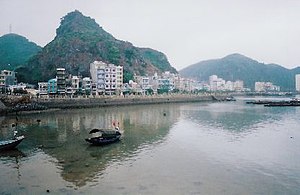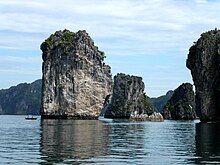Cát Bà
| Cát Bà | ||
|---|---|---|
| Cát Bà (2006) | ||
| Waters | Gulf of Tonkin | |
| Geographical location | 20 ° 48 ′ N , 107 ° 0 ′ E | |
|
|
||
| length | 21 km | |
| width | 13.5 km | |
| surface | 140 km² | |
| Highest elevation | Ngu Lam 332 m |
|
| Residents | 13,000 93 inhabitants / km² |
|
| main place | Cát Bà city | |
Cát Bà is the largest island in Halong Bay in northern Vietnam . It belongs to a biosphere reserve established by UNESCO in 1994 and has been home to a Vietnamese national park , the Cát-Bà National Park , since 1986 .
Cát Bà is important for the conservation of biodiversity as it has endemic , rare and endangered species , economically important species, rare habitats and an artisanal fishery.
geography
The island is located about 20 km east of the city of Hải Phong .
Like the other more than 2000 islands in the region include the 354 square kilometer island of Cat Ba in a limestone - plateau , which continues gradually falls into the sea. The largest city on the island, Cát-Bà-Stadt, is located in the southwest of the island and is inhabited by around 12,000 people.
nature
There are rare habitats on Cát Bà: the surrounding coral reefs are the furthest north of their species. In addition, there are swamp forests made up of willows and mangrove forests , which have become rare in northern Vietnam.
Animal species
Endemic, rare and endangered species such as langurs live on Cát Bà . The endemic golden-headed tangle Trachypithecus poliocephalus is one of the world's rarest and most endangered primate species. Its population only consists of about 800 adult animals on the Cát-Bà archipelago and can therefore be described as precarious. In 2007, the endemic gecko Goniurosaurus catbaensis was discovered during a German-Vietnamese expedition . Green turtles (Chelonia mydas) and hawksbill turtles (Eretmochelys imbricata) are also found in the archipelago . Other advocated here rare and endangered species of marine animals are the sea horse (Hippocampus sp.), Several types of screw with a conical in about snail shell, as to the trochidae belonging and sought-after for the mother of pearl types of production troche niloticus and troche pyramis, to the abalone belonging screw Haliotis diversicolor and the clams belonging Lutraria rhinchena .
plants
Many of the rare and endemic plant species found in the archipelago are also of economic importance to the region. The yellow orchid species Paphiopedilum concolor, the palm fern species Cycas tropophylla and the dragon blood tree Dracaena cambodiana are valued as decorative plants. Some varieties like the Hibiscus tiliaceus are used to make mats. The leaves of the succulent Gynura auriculata are edible, as are the soft fruits of the false orange Maclura cochinchinensis . Other varieties have medicinal properties, such as the tuber of the liana species Stephania rotunda or the swollen trunks of the tree fern Drynaria bonii .
Development of the region
The Cát Bà archipelago fulfills an important economic function in the development of Vietnam. The government therefore promotes tourism , supports regional fishing and agriculture. International projects work with the government of Vietnam with the aim of keeping the effects of the rapidly increasing tourism on the unique ecological situation of Cát Bàs as low as possible. Organizations such as the Australian Foundation for the Peoples of Asia and the Pacific ( AFAP ) criticize, however, that the measures taken so far are insufficient.
fishing
In the Cát-Bà Archipelago, fishing is mainly carried out close to the shore, and the nature of the coastal waters limits the size of the fishing boats. Traditional boats are still used. Larger boats are traditionally made from waste wood, while smaller boats are woven from rattan , which is sealed with tar . The Cát-Bà Archipelago is an important coastal fishing spot for North Vietnam, it attracts fishing boats from many other provinces. There is a long tradition of regional fishing in this area with dependent migrant workers who exploit the region's maritime resources.
Since 1960, hundreds of fishing boats have been competing in the near-shore area of the Cát Bà Islands. Today, fishing is intensified in areas that are rich in fish and further away from the shore in northern Vietnam.
Agriculture and maritime breeding efforts
There have been many efforts to encourage small-scale commercial agriculture and attempts to cultivate economically viable marine life in the depressions of the larger island and in the many small sheltered bays of the archipelago.
The biosphere reserve supports the sociological , cultural and ecological development by resolving possible conflicts of interest that arise from nature conservation and the need for an economic use of nature.
Zones of the reserve
In the course of efforts to reconcile ecological, economic and cultural interests, the reserve has been divided into several zones with different degrees of protective measures and usage permits.
Core zones 1 and 2
8,500 ha in the southwest of the archipelago were classified in IUCN Category II in 1986 as a protected area of the Cát-Bà National Park . This includes 6,500 hectares of land and 2,000 hectares of sea. The objectives here are the preservation of the natural ecosystems and the gene pool of flora and fauna , the preservation of cultural and historical peculiarities, the recovery of the original flora through restoration and the initiation of habitat improvements for the corresponding species of flora and fauna, as well as training in cooperation with the tourism industry. In addition, the scientific research required for park management is to be intensified.
Buffer zone 1
This zone was also partially classified in 1986 as an IUCN Category II protected area of the national park. The whole area covers 7,641 hectares, of which 4,941 hectares are on land and 2,700 in the sea. In addition to the above-mentioned conditions, use by fruit trees, beekeeping , main gardens and rice cultivation , as well as pearl cultivation and sea fish culture are permitted here, as well as coastal fishing such as sand crab and mantis shrimp harvests , regional fishing operations, and the collecting of mussels in the rocky area Shore allowed. There is also potential for regional tourism based on the natural landscapes of the national park.
Buffer zone 2
This zone was also classified in 1986 as a protected area of IUCN Category II in the national park. The area covers 141 hectares and surrounds a village called Việt Hải. The cultivation of fruit trees, beekeeping, main gardens and commercial rice processing are permitted here, as well as regional tourism based on the natural landscapes of the national park.
Transition zone 1
The majority of the population of the island of Cát Bà living outside the city of Cát Bà, estimated at approx. 4000 people, live in this zone, which is 8700 hectares in size and covers 4500 hectares of land and 4200 hectares of sea area. In 2002, a new coastal road was laid out to promote socio-economic development and provide the opportunity to accommodate immigrants. It also improves the conditions for diversification of the island's service and agricultural sectors. There are some tourist spots in this area that weren't used until the plans were made, including a hot spring and new beach areas.
The use of the sea coast for the culture of maritime resources dominates the economy in the northern section. One focus here is on shrimp management. To this end, large areas of the mangrove forests have been illegally destroyed in the past. There were air - infrastructure projects planned, including an improvement of the fresh water supply, sewage and waste disposal.
Transition zone 2
In this 1300 hectare zone there is a city with a population of 235 people on 1100 hectares. The marine area in this zone covers 200 ha. It was estimated that 40 percent of households were at least partially dependent on the resources of the forest. Here, too, a new road was laid out with the plan to create a new landing stage in order to create a faster alternative for tourists to reach Cát-Bà-City from the neighboring, touristic Halong Bay. It is hoped that this will increase the attractiveness of the island for tourists and in this way tourism can replace the forest gardens and fruit orchards as the main source of income.
History and culture
Before the National Park was established in 1986, Cát Bà was a concession to forestry. The island of Cát Bà and the surrounding sea have a long history of human use. Archaeological finds show that Cát Bà has been inhabited for at least 6000 years. Two ethnic groups live in the biosphere reserve area: approx. 5000 Kinh and approx. 200 Vietnamese of Chinese origin. These ethnic groups are mixed and not separated into different areas or communities. However, their presence has a devastating effect on the island's nature.
Cát Bà has 42 archaeological sites. They contain paleontological traces of a culture in the Pleistocene . Seven sites belong to more recent prehistoric periods, two are related to historical eras . There are also eight caves and archaeological and cultural traces of stone roofs. Prehistoric sites in various caves are scattered around the island and are usually also accessible to tourists. Various research groups have carried out archaeological investigations.
The locations correspond to a characteristic pattern. The found relics made of stone, pottery and ceramic fragments point to the "Bac-Sohn culture" at a later stage, about 6000 years ago. The Cai-Beo site is located on a sandy bottom near the sea 1.5 kilometers southeast of Cát-Bà-Stadt.
The archaeological finds show that the people in the region lived in a maritime climate and that Cát-Bà was previously connected to the continent . There are paleontological relics of the Pleistocene in four caves. Among them is the Hoa Cave near the town of Gia Luan, which has some animal fossils such as deer , sambar deer, rhinos , porcupines and orangutans . Tombs were found in the caves on Cát Bà in the Khau Quy cave near Thien Lang and in the Ang Giua cave near the city of Việt Hải. The bone finds are characteristic of Austral-Melanesian people.
Among the cultural artifacts and monuments on Cat Ba there are temple sites and ancient citadels of Macdynastie .
Festivals such as a canoe rowing competition, various regattas, a sea god ceremony and a fishing festival have become tourist attractions.
Sources as individual references
- ↑ Travel magazine at web.de: Article about tourism in Vietnam with a statement from AFAP ( Memento of the original from October 26, 2006 in the Internet Archive ) Info: The archive link was automatically inserted and not yet checked. Please check the original and archive link according to the instructions and then remove this notice.





